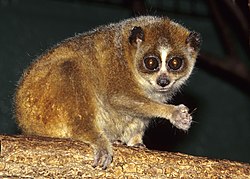Portal:Primates
The Primates Portal A primate is a member of the biological order Primates, the group that contains lemurs, the aye-aye, lorisids, galagos, tarsiers, monkeys, and apes, with the last category including great apes. With the exception of humans, who inhabit every continent on Earth, most primates live in tropical or subtropical regions of the Americas, Africa and Asia. Primates range in size from the 30-gram (1 oz) pygmy mouse lemur to the 200-kilogram (440 lb) mountain gorilla. According to fossil evidence, the primitive ancestors of primates may have existed in the late Cretaceous period around 65 mya (million years ago), and the oldest known primate is the Late Paleocene Plesiadapis, c. 55–58 mya. Molecular clock studies suggest that the primate branch may be even older, originating in the mid-Cretaceous period around 85 mya. Primates exhibit a wide range of characteristics. Some primates do not live primarily in trees, but all species possess adaptations for climbing trees. Locomotion techniques used include leaping from tree to tree, walking on two or four limbs, knuckle-walking, and swinging between branches of trees (known as brachiation). Primates are characterized by their large brains relative to other mammals. These features are most significant in monkeys and apes, and noticeably less so in lorises and lemurs. Many species are sexually dimorphic, which means males and females have different physical traits, including body mass, canine tooth size, and coloration.
Selected article
Slow lorises (genus Nycticebus) are strepsirrhine primates found in South and Southeast Asia. They range from Northeast India to the southern Philippines and from the Yunnan province in China in the north to the island of Java in the south. There are currently five species recognized: Sunda slow loris (N. coucang), Bengal slow loris (N. bengalensis), pygmy slow loris (N. pygmaeus), Javan slow loris (N. javanicus), and the Bornean slow loris (N. menagensis). Slow lorises are most closely related to other lorisids, such as slender lorises, pottos, the false potto, and angwantibos.
Like other living ("crown") strepsirrhines, these nocturnal primates have a reflective layer in their eye called the tapetum lucidum, which enhances their night vision. They also have a rhinarium or "wet nose", which is a touch-based sense organ. Because of their close relation to lemurs and other lorisiforms, they also possess a toothcomb, which is used in personal and social grooming, as well as feeding. Like nearly all prosimian ("pre-monkey") primates, they have a toilet-claw, which is also used in grooming. Slow lorises have a round head, narrow snout, large eyes, and distinctive coloration patterns. Their arms and legs are nearly equal in length, and their trunk is long, allowing them to twist and extend to nearby branches. The hands and feet of slow lorises have several adaptations that give them a pincer-like grip and enable them to grasp branches for long periods of time. Slow lorises and possibly some of their closest relatives have a toxic bite—a rare trait among mammals. Little is known about their social structure, but they are known to communicate by scent-marking. Males are highly territorial. Slow lorises reproduce slowly, and the infants are initially parked on branches or carried by either parent. They are omnivores, eating small animals, fruit, tree gum, and other vegetation. All slow loris species are listed as either "Vulnerable" or "Endangered" on the International Union for Conservation of Nature and Natural Resources Red List of Threatened Species (IUCN Red List) and are threatened by the wildlife trade and habitat loss. Although their habitat is rapidly disappearing and becoming fragmented, making it nearly impossible for slow lorises to disperse between forest fragments, unsustainable demand from the exotic pet trade and traditional medicine has been the greatest cause for their decline. Selected picture The white-fronted capuchin, Cebus albifrons, is a species of capuchin monkey, a type of New World primate, found in seven different countries in South America: Bolivia, Brazil, Colombia, Venezuela, Ecuador, Peru, and Trinidad and Tobago. The species is divided into several different subspecies, though the specific divisions are uncertain and controversial. CategoriesSelected species Vulnerable (IUCN 3.1)|Vulnerable The pygmy slow loris (Nycticebus pygmaeus) is a species of slow loris found east of the Mekong River in Vietnam, Laos, eastern Cambodia, and China. It occurs in a variety of forest habitats, including tropical dry forests, semi-evergreen, and evergreen forests. The animal is nocturnal and arboreal, crawling along branches using slow movements in search of prey. It lives together in small groups usually with one or two offspring. An adult can grow to around 19 to 23 cm (7.5 to 9.1 in) long and has a very short tail. It weighs about 450 g (1.0 lb). Its diet consists of fruits, insects, small fauna, tree sap, and floral nectar. The animal has a toxic bite. The pygmy slow loris mates once every 12–18 months and has one or two offspring after an average gestation period of six months. Females reach sexual maturity by 16 months, while males reach maturity by about 18 months. The pygmy slow loris is seasonally fertile during the months of July and August. The habitat of the pygmy slow loris in Vietnam was greatly reduced due to extensive burning, clearing, and defoliating of forests during the Vietnam War. Extensive hunting for traditional medicines is currently putting severe pressure on Cambodian populations. The pygmy slow loris is seriously threatened by hunting, trade, and habitat destruction; consequently, it is listed in Appendix II of the Convention on International Trade in Endangered Species of Wild Fauna and Flora (CITES), and in 2006 the International Union for Conservation of Nature (IUCN) classified it as "Vulnerable". Did you know?
Primate lists
WikiProjectsThings to do
Associated WikimediaDiscover Wikipedia using portals |

















